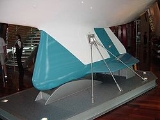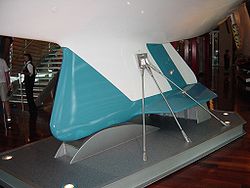
Winged keel
Encyclopedia

Keel
In boats and ships, keel can refer to either of two parts: a structural element, or a hydrodynamic element. These parts overlap. As the laying down of the keel is the initial step in construction of a ship, in British and American shipbuilding traditions the construction is dated from this event...
, usually of moderate aspect ratio
Aspect ratio (wing)
In aerodynamics, the aspect ratio of a wing is essentially the ratio of its length to its breadth . A high aspect ratio indicates long, narrow wings, whereas a low aspect ratio indicates short, stubby wings....
, that uses a nearly horizontal foil
Foil (fluid mechanics)
A foil is a solid object with a shape such that when placed in a moving fluid at a suitable angle of attack the lift is substantially larger than the drag...
, the "wing
Wing
A wing is an appendage with a surface that produces lift for flight or propulsion through the atmosphere, or through another gaseous or liquid fluid...
", at the bottom to provide additional performance. Note that the wing is upside down with relation to the boat. The horizontal foil serves two purposes: it acts as a winglet on the foil, effectively doubling the aspect ratio
Aspect ratio (wing)
In aerodynamics, the aspect ratio of a wing is essentially the ratio of its length to its breadth . A high aspect ratio indicates long, narrow wings, whereas a low aspect ratio indicates short, stubby wings....
by reducing lift-induced drag
Lift-induced drag
In aerodynamics, lift-induced drag, induced drag, vortex drag, or sometimes drag due to lift, is a drag force that occurs whenever a moving object redirects the airflow coming at it. This drag force occurs in airplanes due to wings or a lifting body redirecting air to cause lift and also in cars...
, and they produce additional lift, but downwards. Because the yacht is heeled over when sailing upwind the leeward foil is closer to vertical, and provides additional side force hence making the boat sail upwind more efficiently. The windward winglet is closer to horizontal and hence produces a force directly downward, which gives a small benefit to the vessel's stability.
Winged keels are generally found on high performance sailboats, if they are not prohibited by class rules. They are only of benefit for yachts sailing upwind where stability and the ability to produce side force are important. Downwind the extra skin friction drag
Drag (physics)
In fluid dynamics, drag refers to forces which act on a solid object in the direction of the relative fluid flow velocity...
is a hindrance. Besides the performance benefits, winged keels can also be applied to pleasure boats as a way to reduce draft
Draft (hull)
The draft of a ship's hull is the vertical distance between the waterline and the bottom of the hull , with the thickness of the hull included; in the case of not being included the draft outline would be obtained...
, allowing for greater versatility when gunkholing
Gunkholing
Gunkholing is a boating and sea kayaking term referring to a type of cruising in shallow or shoal water, meandering from place to place, spending the nights in coves. The term refers to the gunk, or mud, typical of the creeks, coves, marshes, sloughs, and rivers that are referred to as gunkholes...
.
The winged keel made its first appearance on a 12 metre class yacht in the 1983 America's Cup
America's Cup
The America’s Cup is a trophy awarded to the winner of the America's Cup match races between two yachts. One yacht, known as the defender, represents the yacht club that currently holds the America's Cup and the second yacht, known as the challenger, represents the yacht club that is challenging...
Australia
Australia
Australia , officially the Commonwealth of Australia, is a country in the Southern Hemisphere comprising the mainland of the Australian continent, the island of Tasmania, and numerous smaller islands in the Indian and Pacific Oceans. It is the world's sixth-largest country by total area...
n challenger Australia II
Australia II
Australia II is the Australian 12-metre-class challenge racing yacht that was launched in 1982 and won the 1983 America's Cup for the Royal Perth Yacht Club...
. Along with Australia II's radical sail design, this keel designed by Ben Lexcen
Ben Lexcen
Ben Lexcen AM born Robert Miller was an Australian yachtsman and marine architect. He is famous for the winged keel design applied to Australia II which, in 1983, became the first non-American yacht to win the prestigious America's Cup in 132 years.-Early life:Born in the coastal town of...
was one of the factors contributing to Australia II's success. The increased stability afforded by the winged keel, due mainly to the extra lead in the wings producing a very low centre of gravity, allowed Australia II to be as short and light as possible under the 12 meter rules, and still carry enough sail to beat the American
United States
The United States of America is a federal constitutional republic comprising fifty states and a federal district...
entry, helmed by Dennis Conner
Dennis Conner
Dennis Conner is an American yachtsman, noted for winning the bronze medal at the 1976 Olympics, two Star World Championships, and four wins in the America's Cup.-America's Cup:...
. The wings were angled downwards at about 20 degrees, which, since they were lifting downwards, acted as a dihedral.
Most winged keels also incorporate a significant amount of ballast
Sailing ballast
Ballast is used in sailboats to provide moment to resist the lateral forces on the sail. Insufficiently ballasted boats will tend to tip, or heel, excessively in high winds. Too much heel may result in the boat capsizing. If a sailing vessel should need to voyage without cargo then ballast of...
where the wings join the keel. This feature makes these winged keels also a type of bulb keel
Bulb keel
200px|right|Flat Keel bulbA bulb keel is a keel, usually made with a high aspect ratio foil, that contains a ballast-filled bulb at the bottom, usually teardrop shaped. The purpose of the bulb keel is to place the ballast as low as possible, therefore gaining the maximum possible amount of...
.

